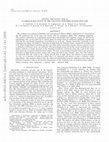Papers by Richard Patterson

Noao Proposal, Aug 1, 2005
The primary scientific goal of this program is to detect and map the tidal streams emanating from... more The primary scientific goal of this program is to detect and map the tidal streams emanating from halo globular clusters. We propose to obtain moderately deep V and I imaging of the regions within 2° of the centers of five globular clusters with R_sun < 50 kpc and with a high probability of having strong tidal tails. Given that these cold tidal streams are on essentially the same orbits as their parent clusters, they can be used to constrain both the formation and evolution of the Galactic halo as well as the present shape of the Galactic potential field. With follow-up spectroscopy to eliminate foreground contaminants, the stars in these tidal streams will be used to construct a high-priority target list for the Space Interferometry Mission (SIM). Proper motion measurements of these stars with SIM will enable us to tightly constrain the detailed, three-dimensional structure of the Galactic potential field from the Solar Circle out to 50 kpc.

Astron J, 2002
We present a large area photometric survey of the Ursa Minor dSph. We identify UMi giant star can... more We present a large area photometric survey of the Ursa Minor dSph. We identify UMi giant star candidates extending to ~3 deg from the center of the dSph. Comparison to previous catalogues of stars within the tidal radius of UMi suggests that our photometric luminosity classification is 100% accurate. Over a large fraction of the survey area, blue horizontal branch stars associated with UMi can also be identified. The spatial distribution of both the UMi giant stars and the BHB stars are remarkably similar, and a large fraction of both samples of stars are found outside the tidal radius of UMi. An isodensity contour map of the stars within the tidal radius of UMi reveals two morphological peculiarities: (1) The highest density of dSph stars is offset from the center of symmetry of the outer isodensity contours. (2) The overall shape of the outer contours appear S-shaped. We find that previously determined King profiles with ~50' tidal radii do not fit well the distribution of our UMi stars. A King profile with a larger tidal radius produces a reasonable fit, however a power law with index -3 provides a better fit for radii > 20'. The existence of UMi stars at large distances from the core of the galaxy, the peculiar morphology of the dSph within its tidal radius, and the shape of its surface density profile all suggest that UMi is evolving significantly due to the tidal influence of the Milky Way. However, the photometric data on UMi stars alone does not allow us to determine if the candidate extratidal stars are now unbound or if they remain bound to the dSph within an extended dark matter halo. (Abridged)

Astrophys J, 2006
Extended halo tidal streams from disrupting Milky Way satellites offer new opportunities for gaug... more Extended halo tidal streams from disrupting Milky Way satellites offer new opportunities for gauging fundamental Galactic parameters without challenging observations of the Galactic center. In the roughly spherical Galactic potential, tidal debris from a satellite system is largely confined to a single plane containing the Galactic center, so accurate distances to stars in the tidal stream can be used to gauge the Galactic center distance, R0, given reasonable projection of the stream orbital pole on the XGC axis. Alternatively, a tidal stream with orbital pole near the YGC axis, such as the Sagittarius stream, can be used to derive the speed of the local standard of rest (ΘLSR). Modest improvements in current astrometric catalogs might allow this measurement to be made, but NASA's Space Interferometry Mission (now SIM PlanetQuest) can definitively obtain both R0 and ΘLSR using tidal streams.

The Sagittarius (Sgr) dwarf galaxy+tidal tail system provides a clear example of a Milky Way (MW)... more The Sagittarius (Sgr) dwarf galaxy+tidal tail system provides a clear example of a Milky Way (MW) satellite in tidal disruption. But is Sgr the exception or paradigm of dSph galaxies? Interesting clues suggest the latter: Other MW dSphs exhibit very extended surface brightness profiles and approximately flat velocity dispersion profiles, as does Sgr out into its tidal arms and as do N-body models of disrupting dSphs. But only in the Carina dSph have we found another clear set of tidal tails (Munoz et al. 2006,2008). Nevertheless, yet more tidally disrupting MW dSphs is a problem for CDM, which predicts that nearly all should have their luminous parts securely protected within dark matter cocoons. Thus, it is critical to determine if other dSphs sharing the structural and velocity patterns of Sgr and Carina at inner radii have tidal tails at larger radii. As with our successful Carina study, we made large MOSAIC maps around the Leo I (4.5 deg^2) and Ursa Minor (17 deg^2) dSphs to find tidal tails. While in both cases follow-up spectroscopy reveals numerous velocity dSph members beyond the King radius, definitive tails are not yet outlined. We propose to finish the Leo I and Ursa Minor studies, and determine whether CDM has a new problem on small scales (i.e. that there are too many tidally disrupting dSphs compared to expectations from (Lambda)CDM models).

Bulletin of the American Astronomical Society, Dec 1, 1994
CCD B- and I-band surface photometry is presented for a sample of 51 dwarf and low surface bright... more CCD B- and I-band surface photometry is presented for a sample of 51 dwarf and low surface brightness galaxies. The main selection criterion was their extremely narrow HI linewidths (Delta {V}20<100 km s(-1) ), chosen in order to examine the Tully--Fisher (TF) relation between linewidth and absolute magnitude at the low--luminosity end. In this regime, a substantial fraction of the linewidth is attributable to turbulent rather than rotational motion. Therefore, it is not surprising that the original TF relation, an expression of the scaling relation between mass (from the linewidth due to rotation) and luminosity, does not hold in this regime. If we assume the linewidth is due to both turbulent and rotational motion, we obtain a mass for the dwarfs which does correlate with luminosity. However, the relation is distinct from the TF relation for spirals, and indicates the presence of an increasing amount of dark matter at low luminosities. We find that the locus of dwarf galaxies in the mass/luminosity plane is well fit by the theoretical prediction of Dekel & Silk [1986, ApJ, 303, 39], M/L~{L}(-0.37) , where M/L decreases with increasing L, while the spirals follow a relation in which M/L increases with increasing L (M/L~{L}(0.2) ), which corresponds to the observed slope ( ~ {7}) of the TF relation for spirals. For dwarfs fainter than L_B/Lsun ~ {10(7}) , the observed M/L is ~ {20}, while it drops to unity for L_B/Lsun ~ {10(9.5}) . The Dekel--Silk relation arises in low mass systems with massive dark halos which undergo extensive mass loss due to supernova--driven winds. The halo allows the galaxy to remain bound even as most of the gas is removed, drastically reducing the rate of star formation. The trend towards higher M/L at lower L is the result of the lower escape velocity of the less massive systems, allowing the gas to be removed more efficiently. The same relation has previously been seen to hold for dwarf Spheroidal galaxies, providing further evidence for a common evolutionary history of these two types of dwarf systems, radically different from ``normal'' early-- and late--type galaxies.

Noao Proposal, Aug 1, 2006
Though it is now clear that accretion of dwarf galaxies likely played a prominent role in creatin... more Though it is now clear that accretion of dwarf galaxies likely played a prominent role in creating the Milky Way (MW) halo, the chemical abundance patterns of current MW satellites are typically very different than those of halo stars, and the reason for these differences remains a matter of speculation. We propose to test the bridge from dwarf galaxy to halo star directly by exploring chemical trends along the tidal tails of disrupting dwarf galaxies. Our initial abundance analysis on debris from the Sagittarius (Sgr) dwarf galaxy has already revealed a significant [Fe/H] trend along the leading arm from the core to debris stripped some 2 Gyr ago from the satellite. This trend vividly demonstrates the origin of differences between current dwarf galaxies and the stars they contributed to the halo and presents a new method for mapping the star formation and dynamical histories of galaxies. We propose to improve our analysis of the Sgr stream by undertaking echelle resolution observations of stars in the dynamically simpler trailing arm of Sgr. We also plan to repeat this analysis on the Monoceros (Mon)/Canis Major/Argo and Tri-And systems to: (1) establish whether Mon is a satellite tidal stream and not the Galactic warp, (2) test the putative associations of Canis Major, Argo and Tri- And with Mon, and (3) search for abundance variations along the Mon stream like those seen for the Sgr stream.

Noao Proposal, Aug 1, 2008
The Sgr dwarf galaxy + tidal tail system, now extensively explored with 2MASS M giants, provides ... more The Sgr dwarf galaxy + tidal tail system, now extensively explored with 2MASS M giants, provides a clear example of a Milky Way (MW) satellite in tidal disruption. But long considered the exception on this regard, Sgr might prove to be a paradigm for at least some other dSph galaxies since recent studies suggest that the Leo I and Carina dSphs are also currently undergoing tidal stripping. Like Sgr and Leo I, Carina shows a flat/rising velocity dispersion, σ_v, from the core out to ~2.5× its King radius (r_lim). Our models of a significantly tidally disrupting, dark matter-dominated dSph can fit the observed morphology and dynamics of the Carina dSph and we have spectroscopically confirmed numerous Carina stars out to 9r_lim; these stars clearly outline a linear, tidal tail-like structure. Here, we propose to continue our spectroscopic survey of Carina to 10-12r_lim. Any Carina stars found at these radii have to be tidal debris (to have them bound to the satellite it would require Carina to have >10% the mass of the MW). As has been shown with, e.g., Sgr and Pal 5, the variation of the radial velocities over a large range of the tidal tails provides a strong constraint on the orbit of the satellite, and helps constrain both the mass of the satellite and the potential of the MW at the distance of Carina (100 kpc). In addition, our spectroscopic surveys in the Carina area have resulted in the discovery of numerous LMC stars out to ~26° from the LMC center, suggesting that the outer edge of this satellite has not yet been reached.

We report preliminary results of a >4 degrees2 survey of the Leo II dwarf spheroidal (dSph) galax... more We report preliminary results of a >4 degrees2 survey of the Leo II dwarf spheroidal (dSph) galaxy using the Washington M and T2 filters and the stellar gravity-sensitive DDO51 filter. Using the technique outlined by Majewski et al. (2000, AJ, 119, 760), we map the spatial distribution of potential Leo II giant stars. The distribution of candidate Leo II giants shows several intruiging features, including a small outcropping from the main body of the dSph that extends to the tidal radius. This outcropping is also apparent on the starcount contour maps of Irwin & Hatzidimitriou (1995). We have revised Leo II's structural parameters from a deep UBV survey using both classical starcount methods and an analysis of the surface brightness profile of unresolved stars in a star-subtracted image of the dSph. The outcropping appears to be aligned with this revised major axis. A few potential Leo II RGB stars lie outside of its tidal radius. However, the signal is not much greater than the statistical noise. Spectroscopic follow-up will be needed to determine if these extra-tidal stars are indeed associated with Leo II. The small signal, however, suggests that Leo II has either undergone little tidal disruption by the Milky Way or that any tidal debris has drifted away from the dSph during what is speculated to be a very long orbital period along a very eccentric orbit. We acknowledge support for this research from NSF CAREER Award grant AST 97-02521, the David and Lucile Packard Foundation, and the Research Corporation.

We show results from our deep proper-motion survey of Kapteyn's Selected Areas (SAs; Casetti-Dine... more We show results from our deep proper-motion survey of Kapteyn's Selected Areas (SAs; Casetti-Dinescu et al. 2006, AJ,132,2082), with a focus on fields that intersect the Sagittarius (Sgr) trailing tidal stream. Our data set, derived from matched, deep photographic plate pairs taken nearly 100 years apart, provides a unique window on the motions of stars in these SA fields. We find the signature of a common-motion population among our accurate proper motions of stars in five of these fields, as well as corresponding stellar excesses which are identified as stellar debris from the disrupted Sgr dwarf. Spectroscopic follow-up confirms that these stars are Sgr members, and the resultant radial velocities and spectroscopic parallaxes are combined with proper motions to derive full space motions of 30-100 tidal stream members per field. These kinematical data are compared to the predictions of the Law et al. (2009, ApJL,703,67) models of Sgr disruption, which have thus far reproduced most observed features of the Sgr stream, and have also constrained the triaxial shape of the Milky Way's dark matter halo. We also derive low-resolution spectroscopic abundances along this stretch of the Sgr stream, and explore the stream metallicity gradient reported by Chou et al. (2007, ApJ,670,346). Majewski et al. (2006, ApJL,627,25) showed that because the Sgr debris plane is nearly coincident with the Galactic X-Z Cartesian plane, proper motions in the portion of the Sgr trailing tail in our study almost entirely reflect the solar motion, and can be used to make a direct measurement of the rotation speed at the Solar circle (the "Local Standard of Rest") almost completely independent of the Sun's distance from the Galactic center. Here, we report our derived constraints on the solar motion from absolute proper motions of Sgr debris in our SA fields.

We have assembled the first all-sky view of the Sagittarius (Sgr) dwarf galaxy and its tidal tail... more We have assembled the first all-sky view of the Sagittarius (Sgr) dwarf galaxy and its tidal tail system by identifying constituent M giant stars with 2MASS. This infrared photometry yields a clean image of the Sgr core, which follows a ``King + power law break" profile that looks identical to break profiles previously observed (and debated) in other Galactic dSphs. Sgr is the most accessible member of this family of dSphs, and one where the break is from certain tidal disruption. We seek 1 km/s radial velocities (RVs) of Sgr stars within the King radius to determine whether and how disruption affects the velocity profiles of dSphs, for direct comparison to dSph dark matter and disruption models as well as velocity data in these other dSphs. We also find prominent leading and trailing tidal arms wrapped completely around the Galaxy. Several km/s RVs for stars in these arms will help to determine their true length (therefore the duration of the Sgr-Milky Way interaction), discriminate whether/where the leading arm passes through the Galactic plane on this side of the Galactic center, define the Sgr orbit with high precision and constrain the form of the Galactic potential, and yield insights into how an apparently fluffy Sgr could have survived for a Hubble time.
The Department of Astronomy at the University of Virginia has embarked on an ambitious program to... more The Department of Astronomy at the University of Virginia has embarked on an ambitious program to expand their education and public outreach (E/PO) program. The comprehensive program addresses undergraduate education for non-science majors, teacher professional development, outreach programs for local schools, informal science education through collaborations with museums, and outreach through the public night program at McCormick Observatory. This poster presents example programs and their outcomes, including funding and staffing strategies. We believe that this E/PO program could serve as a model for other departments wishing to begin, or expand, an E/PO program. The E/PO program has been supported by funding from the Celerity Foundation, the University of Virginia, and NASA E/PO supplements to Chandra, HST, SIM, and FUSE science programs.

We combine near-infrared (2MASS) and mid-infrared (Spitzer-IRAC) photometry to characterize the I... more We combine near-infrared (2MASS) and mid-infrared (Spitzer-IRAC) photometry to characterize the IR extinction law (1.2-8 microns) over nearly 150 degrees of contiguous Milky Way midplane longitude. The relative extinctions in 5 passbands across these wavelength and longitude ranges are derived by calculating color excess ratios for G and K giant red clump stars in contiguous midplane regions and deriving the wavelength dependence of extinction in each one. Strong, monotonic variations in the extinction law shape are found as a function of angle from the Galactic center, symmetric on either side of it. These longitudinal variations persist even when dense interstellar regions, known a priori to have a shallower extinction curve, are removed. The increasingly steep extinction curves towards the outer Galaxy indicate a steady decrease in the absolute-to-selective extinction ratio (R_V) and in the mean dust grain size at greater Galactocentric angles. We note an increasing strength of the 8 micron extinction inflection at high Galactocentric angles and, using theoretical dust models, show that this behavior is consistent with the trend in R_V. Along several lines of sight where the solution is most feasible, A_lambda/A_Ks as a function of Galactic radius is estimated and shown to have a Galactic radial dependence. Our analyses suggest that the observed relationship between extinction curve shape and Galactic longitude is due to an intrinsic dependence of the extinction law on Galactocentric radius.

ABSTRACT The primary laboratory for developing and testing models of galaxy formation, structure,... more ABSTRACT The primary laboratory for developing and testing models of galaxy formation, structure, and evolution is our own Milky Way, the closest large galaxy and the only one in which we can resolve large numbers of individual stars. The recent availability of extensive stellar surveys, particularly infrared ones, has enabled precise, contiguous measurement of large-scale Galactic properties, a major improvement over inferences based on selected, but scattered, sightlines. However, our ability to fully exploit the Milky Way as a galactic laboratory is severely hampered by the fact that its midplane and central bulge -- where most of the Galactic stellar mass lies -- is heavily obscured by interstellar dust. Therefore, proper consideration of the interstellar extinction is crucial. This thesis describes a new extinction-correction method (the RJCE method) that measures the foreground extinction towards each star and, in many cases, enables recovery of its intrinsic stellar type. We have demonstrated the RJCE Method&#39;s validity and used it to produce new, reliable extinction maps of the heavily-reddened Galactic midplane. Taking advantage of the recovered stellar type information, we have generated maps probing the extinction at different heliocentric distances, thus yielding information on the elusive three-dimensional distribution of the interstellar dust. We also performed a study of the interstellar extinction law itself which revealed variations previously undetected in the diffuse ISM and established constraints on models of ISM grain formation and evolution. Furthermore, we undertook a study of large-scale stellar structure in the inner Galaxy -- the bar(s), bulge(s), and inner spiral arms. We used observed and extinction-corrected infrared photometry to map the coherent stellar features in these heavily-obscured parts of the Galaxy, placing constraints on models of the central stellar mass distribution.

Bulletin of the American Astronomical Society, Nov 29, 2006
Understanding the formation of galaxies and their structural subcomponents is a key goal of moder... more Understanding the formation of galaxies and their structural subcomponents is a key goal of modern cosmology. Large spiral galaxies like our own consist of a flattened rotating disk, a centrally concentrated bulge whose density decreases exponentially with increasing radius, and an extended halo whose density scales as an inverse power law in radius. Our internal vantage point is disadvantageous for investigating the structure of our own Galaxy. By contrast, the Andromeda spiral galaxy (M31), the Milky Ways neighbour, offers us a global external perspective and yet is close enough for individual stars to be resolved. Over several decades, structural studies of M31 have generally concluded that its outer spheroid is an extension of its inner bulge, displaying the characteristic exponential cut-off out to a distance of about 20 kpc from the center, and/or that its halo is undetected or absent. We report here on the discovery of a halo of red giant stars in M31 extending beyond a radius of 150 kpc. Our finding shows that previous studies of the spheroid of M31 spanning the last few decades have been sampling its extended bulge instead of the pristine metal-poor halo. Characterizing the dynamics, metallicity, substructure, and age of M31's halo will provide unique tests of galaxy formation theories. This research was supported by funds from the NSF and NASA/STScI.

We present reliable measurements of the metallicity distribution function (MDF) at different poin... more We present reliable measurements of the metallicity distribution function (MDF) at different points along the tidal stream of the Sagittarius (Sgr) dwarf spheroidal (dSph) galaxy, based on high resolution, echelle spectroscopy of candidate M giant members of the Sgr system. The Sgr MDF is found to evolve significantly from a median [Fe/H] ~-0.4 in the core to ~-1.1 dex over a Sgr leading arm length representing ~2.5-3.0 Gyr of dynamical (i.e. tidal stripping) age. This is direct evidence that there can be significant chemical differences between current dSph satellites and the bulk of the stars they have contributed to the halo. Our results suggest that Sgr experienced a significant change in binding energy over the past several Gyr, which has substantially decreased its tidal boundary across a radial range over which there must have been a significant metallicity gradient in the progenitor galaxy. By accounting for MDF variation along the debris arms, we approximate the MDF Sgr would have had several Gyr ago. We also analyze the MDF of a moving group of M giants we previously discovered towards the North Galactic Cap having opposite radial velocities to the infalling Sgr leading arm stars there and propose that most of these represent Sgr trailing arm stars overlapping the Sgr leading arm in this part of the sky. If so, these trailing arm stars further demonstrate the strong MDF evolution within the Sgr stream.
Astrophys J, 2010
We present new Keck/DEIMOS spectroscopic observations of hundreds of individual stars along the s... more We present new Keck/DEIMOS spectroscopic observations of hundreds of individual stars along the sightline to Andromeda&amp;amp;amp;amp;amp;amp;amp;amp;amp;amp;amp;amp;amp;amp;amp;amp;amp;amp;amp;amp;amp;amp;amp;amp;#x27;s first three discovered dwarf spheroidal galaxies (dSphs) - And I, II, and III, and leverage recent observations by our team of three additional dSphs, And VII, X, and XIV, as a part of the SPLASH Survey. Member stars of each dSph are isolated from

Bulletin of the American Astronomical Society, Dec 1, 2002
The Bench Spectrograph at the University of Virginia's Fan Mountain Observatory is being built fo... more The Bench Spectrograph at the University of Virginia's Fan Mountain Observatory is being built for use on the facility's primary research telescope, the 1-meter astrometric reflector. The spectrograph is intended for initial use as a dedicated instrument to collect moderate-resolution (10 km s-1) spectra of candidate K giant stars for the Grid Giant Star Survey (GGSS), which is a program to identify stars for the Astrometric Grid of NASA's Space Interferometry Mission (SIM). Because the GGSS candidate sample is extensive, bright (V<13), and uniformly distributed over the sky, a fiber-fed design was selected to provide maximal spectral stability and uniformity while minimally affecting observing efficiency. Spectra will be used primarily for luminosity classification, abundance analysis, and radial velocity measurement. The spectrograph is a single-object, fiber-fed design built largely from off-the-shelf components at modest cost. The primary optics are transmissive, and a 1200 line/mm reflectance grating is used to provide a resolving power of R ˜ 2000 at lambda ˜ 500 nm. Although the primary wavelength region of interest for the GGSS is 480-680 nm, the spectrograph will be usable throughout the optical spectrum. Even with the combination of a modest telescope aperture and the relatively low throughput characteristic of fiber-fed systems, we expect the spectrograph to be useful for medium resolution spectroscopy of stars as faint as V ˜ 14.

Noao Proposal, Aug 1, 2005
Understanding the formation of galaxies and their structural components is a goal of modern cosmo... more Understanding the formation of galaxies and their structural components is a goal of modern cosmology. Cold dark matter (CDM) models make specific predictions about the shape and smoothness of halos, but few halos outside the Milky Way's (MW) have been explored for even the most basic, global properties, while even the MW halo presents some difficulties for study from inside. But the neighboring Andromeda spiral (M31) offers a global external perspective and yet is close enough for us to resolve individual stars. Recently, using Mayall 4-m + Mosaic photometry in the Washington M, T_2 + DDO51 filters and follow- up spectroscopy of identified M31 giant candidates, we made the first direct and unambiguous detection of the M31 halo, and traced its projected r^-2 density profile to 150 kpc along the M31 minor axis. We propose to expand on this discovery with the first systematic photometric and spectroscopic study of the extent, shape, smoothness, and chemodynamics of this newly found M31 component. Latest observations suggest that the MW halo potential is both more smooth and spherical than predicted by CDM models. Our photometric study will test these same fundamental properties of the M31 halo, and whether the MW is simply unusual or whether CDM models need further fine-tuning. Spectroscopic study of a subsample of our existing outer M31 giant sample will provide the first measure of the velocity dispersion, kinematic substructure and metallicity gradient of M31 halo to provide direct constraints on hierarchical formation models.

Noao Proposal, Aug 1, 2002
We propose to measure radial velocities, abundances, and gravities for halo and thick disk giant ... more We propose to measure radial velocities, abundances, and gravities for halo and thick disk giant and HB star candidates identified through a separate photometric survey. The NASA-sponsored Grid Giant Star Survey (GGSS) to find V~12, 5-10 kpc distant giant stars for the Astrometric Grid of the Space Interferometry Mission (SIM) has created a large, systematically assembled catalogue of V≲17.5 giant and HB star candidates. M_V~ -2, metal poor giants at V=17 probe to > 50 kpc. The final catalogue of ~70,000 giant and HB stars provides an unparalleled database for studying the structure, substructure, and chemodynamics of the Milky Way in all directions of the sky. We propose to continue a pilot program of HYDRA spectroscopy of giants and HB stars in 4% of GGSS fields to: (1) assess the richness of GGSS+HYDRA data for probing stellar populations and halo substructure and (2) explore the region where the Sloan Survey has found evidence for a northern extension of the Sgr dSph, and which includes fields where we have found evidence of a new tidal stream, possibly a foreground, > 360°-wrapped Sgr arm. The several thousand new giant/HB spectra will allow us to verify both of these tantalizing tidal debris findings.

We present results of a survey to determine the extended structural profile of the globular clust... more We present results of a survey to determine the extended structural profile of the globular cluster NGC 288. Our mosaic of Swope 1-m telescope CCD fields covers approximately 1 square degree centered on the core of NGC288 and allows us to probe to twice the cluster's tidal radius. To map the cluster to very low densities, we search for stars that have a high likelihood of being (or having been) part of the cluster. First, we are aided by the very distinct, blue horizontal branch (BHB) population of the cluster, and look for all stars with such distinct colors. Second, we identify likely red giant (RGB) stars associated with the cluster. To do this, we image in the broadband Washington M and T2 filters as well as the stellar gravity sensitive DDO51 filter. Giant stars can be distinguished in the (M-T2, M-DDO51) diagram and we make a further winnowing to likely NGC 288 stars by limiting our search to only those giant stars candidates with color-magnitude combinations expected for the NGC 288 red giant and asymptotic branches. A radial profile of the cluster derived from all of ``NGC 288-associated" stars (RGB, BHB, and AGB) shows the NGC 288 candidate stars to follow a King profile to the previously identified tidal radius. However, we do identify an extratidal population of stars at about 10-3 the central density of the cluster, and this results in a break from the King profile near the presumed tidal radius. Based on its structure and orbit, NGC 288 has previously been identified to be among those clusters with higher mass loss rates, and our identification of an ``extratidal tail" to the radial profile would seem to support a significant evaporation/tidal stripping rate. Clearly, at least some globular clusters are making a tangible contribution to the formation of the Milky Way halo. We will present Blanco 4-m + Hydra multifiber spectroscopy of a number of these extratidal RGB and BHB candidates, which will allow us to test the reliability of our extratidal density based on radial velocity membership. This research was supported by the National Science Foundation, The Research Corporation and the David and Lucile Packard Foundation.











Uploads
Papers by Richard Patterson